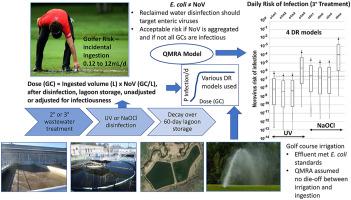Water Research ( IF 11.4 ) Pub Date : 2020-06-30 , DOI: 10.1016/j.watres.2020.116121 Albert Simhon 1 , Vince Pileggi 1 , Cecily A Flemming 1 , George Lai 1 , Mano Manoharan 1

|
About 25 golf courses in Ontario, Canada have environmental compliance approvals to use reclaimed water for irrigation, where disinfection is confirmed through E. coli limits. A previous study at five Ontario municipal wastewater treatment plants (WWTPs) confirmed that enteric viruses are less susceptible to disinfection than E. coli, when plants provided conventional (secondary or tertiary) treatment and routine (chlorine or UV) disinfection. Here we query whether these four treatment-disinfection scenarios plus 60-day lagoon storage of disinfected effluent would be sufficient to reduce norovirus genogroups I and II (NoV GI and GII) risk of infection to tolerable levels for a golfer who incidentally ingests NoV after handling wet golf balls at a golf course irrigated with reclaimed water. We used our RT-qPCR NoV enumeration datasets from the four treatment-disinfection scenarios above and modeled detected and non-detected NoV by Bayesian inference in ‘R’. Monte Carlo simulation included pre-disinfection NoV GI and GII gene copy densities; Ontario WWTP-derived chlorine and UV log10 reductions; literature-derived effluent storage decay parameters and golfer ingested volumes, followed by six different NoV dose-response models. Quantitative Microbial Risk Assessment (QMRA) results suggest that there is an unacceptable NoV infection risk when using the conservative assumption that all detected NoV particles (RT-qPCR gene copies) are infectious, in both aggregated or disaggregated form. However, after adjusting for PCR target sequences and for infectiousness using data from recently published studies on cultivation of human NoV in human intestinal enteroids, we noted a significant reduction of infection risk. However, this less conservative (i.e., less protective) assumption for water reuse applications such as golf course irrigation may not be corroborated until human NoV are efficiently and routinely grown in cell cultures. In addition, further studies on drivers of NoV risk estimation by DR models are needed, e.g., the extent of NoV particle aggregation resulting from wastewater treatment, as well as the role of immunity. Meantime, regulatory agencies could consider more stringent treatment-disinfection requirements that target enteric viruses rather than E. coli and testing of actual reclaimed irrigation waters.
中文翻译:

在用再生水灌溉的高尔夫球场上出现诺如病毒的风险:是否应针对感染性调整QMRA剂量?
加拿大安大略省约有25个高尔夫球场获得了环保合规许可,可使用再生水进行灌溉,并通过大肠杆菌限量确认进行消毒。安大略省五家城市污水处理厂(WWTP)的一项先前研究证实,当工厂提供常规(二级或三级)处理和常规(氯或紫外线)消毒时,肠病毒比大肠杆菌更不容易受到消毒。在这里,我们询问这四种处理消毒方案以及经过消毒的污水在泻湖中存放60天是否足以将诺罗病毒基因组I和II(NoV GI和GII)的感染风险降低到高尔夫球手在处理后偶然摄入NoV的可接受水平用再生水灌溉的高尔夫球场上的湿高尔夫球。我们使用了来自以上四种治疗-消毒方案的RT-qPCR NoV枚举数据集,并通过“ R”中的贝叶斯推断对检测到的和未检测到的NoV进行了建模。蒙特卡洛模拟包括消毒前的NoV GI和GII基因复制密度。安大略污水处理厂产生的氯和紫外线记录10减少;文献中得出的污水存储衰减参数和高尔夫球手的摄入量,然后是六个不同的NoV剂量反应模型。定量微生物风险评估(QMRA)结果表明,使用保守的假设(所有检测到的NoV颗粒(RT-qPCR基因拷贝)都是聚集或分解形式),存在保守的NoV感染风险。但是,在使用最新发表的有关人类肠道小肠中人NoV的培养研究的数据调整了PCR靶序列和传染性之后,我们注意到感染风险显着降低。然而,直到人类NoV在细胞培养物中有效且常规地生长后,这种用于水再利用应用(例如高尔夫球场灌溉)的保守性较低(即保护性较低)的假设可能无法得到证实。此外,还需要对通过DR模型估算NoV风险的驱动因素进行进一步研究,例如,废水处理导致NoV颗粒聚集的程度以及免疫的作用。同时,监管机构应考虑针对肠病毒而不是针对肠病毒的更严格的治疗要求大肠杆菌和实际再生灌溉水的测试。











































 京公网安备 11010802027423号
京公网安备 11010802027423号